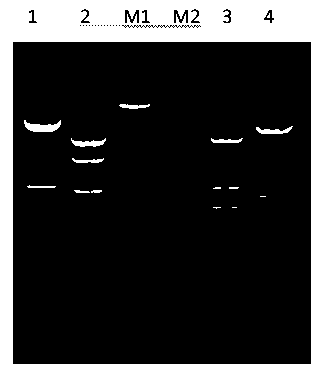Recombinant replication-defective adenovirus for expressing hTERT (human telomerase reverse transcriptase) gene and application thereof
A recombinant adenovirus, adenovirus technology, applied in the field of recombinant adenovirus, can solve problems such as unclear, malignant diseases that cannot be completely cured, etc.
- Summary
- Abstract
- Description
- Claims
- Application Information
AI Technical Summary
Problems solved by technology
Method used
Image
Examples
Embodiment 1
[0023] Example 1 The recombinant plasmid pDC318-hTERT carrying hTERT gene was constructed.
[0024] Take the plasmid pIRES2-EGFP-hTERT previously constructed in our laboratory, cut it with the endonuclease EcoR I, and recover the 4015bp band (hTERT gene). Take the pSG218 vector, cut it with endonuclease EcoR I, and recover the band at 3926bp. The products recovered from the above two enzyme digestions were ligated at 12°C for 12 hours. Then the ligation product was transformed into DH5α Escherichia coli competent cells, spread on an agar plate (containing 100ug / ml AMP) and cultured for 12 hours, picked clones, and amplified on a shaker at 37°C for 12 hours. The plasmid DNA of positive clones was extracted, and identified by restriction enzyme digestion with BamH I, Kpn I + Sac I, Pvu II, and Pst I respectively, and the results were as follows: figure 1As shown (M1 is ΛDNA / EcoRI+HindIII marker, M2 is 100bp DNALadder, lane 1 is the 1519bp + 6422bp fragment obtained by BamH ...
Embodiment 2
[0025] Example 2 Liposome-mediated recombinant plasmid pDC318-hTERT and adenovirus backbone vector pPE3-F11B were co-transfected into human embryonic kidney 293 cells for virus packaging, identification, amplification and titer determination of the recombinant virus.
[0026] 1. Liposome-mediated recombinant plasmid pDC318-hTERT and adenovirus backbone vector pPE3-F11B were co-transfected into human embryonic kidney 293 cells for virus packaging
[0027] The day before transfection, inoculate 7.5 × 10 5 Personal embryonic kidney 293 cells, placed at 37°C, 5% CO 2 Cultured in a cell culture incubator. Change the medium 3-4 hours before transfection, and add 5ml of serum-free medium to ensure the exponential growth of cells. Prepare to transfect the recombinant plasmid pDC318-hTERT obtained in Example 1, the viral backbone vector plasmid pPE3-F11B and liposome Lipofectamine 2000 (purchased from Invitrogen) to transfect 293 cells (specific steps omitted), and the virus appear...
Embodiment 3
[0035] Example 3 The transfection efficiency and expression of the recombinant adenovirus VDC318-hTERT transfected into the target cells in vitro were detected.
[0036] Taking the human multiple myeloma cell line RPMI-8226 as an example, the expression and identification of hTERT gene after the recombinant adenovirus VDC318-hTERT of the present invention was transfected into target cells in vitro was detected, and the specific detection method was as follows:
[0037] 1. Culture of human multiple myeloma cell line RPMI-8226
[0038] Take out the frozen RPMI-8226 cell line from the liquid nitrogen tank, melt it in a 37°C water bath, add RPMI-1640 medium containing 10% FBS, and place it at 37°C, 5% CO 2 Cultured in an incubator for 6 hours, centrifuged at 1000rpm for 5 minutes, and replaced with RPMI-1640 medium containing 10% FBS to remove antifreeze DMSO. Placed at 37°C, 5% CO 2 Cell culture incubator, subculture every 1-2 days or change the medium once in half. Cells in...
PUM
 Login to View More
Login to View More Abstract
Description
Claims
Application Information
 Login to View More
Login to View More - R&D
- Intellectual Property
- Life Sciences
- Materials
- Tech Scout
- Unparalleled Data Quality
- Higher Quality Content
- 60% Fewer Hallucinations
Browse by: Latest US Patents, China's latest patents, Technical Efficacy Thesaurus, Application Domain, Technology Topic, Popular Technical Reports.
© 2025 PatSnap. All rights reserved.Legal|Privacy policy|Modern Slavery Act Transparency Statement|Sitemap|About US| Contact US: help@patsnap.com



